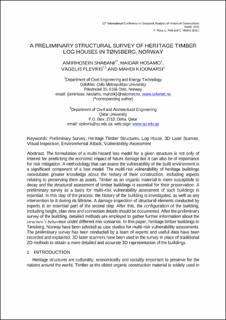| dc.contributor.author | Shabani, Amirhosein | |
| dc.contributor.author | Hosamo, Haidar | |
| dc.contributor.author | Plevris, Vagelis | |
| dc.contributor.author | Kioumarsi, Mahdi | |
| dc.coverage.spatial | Norway, Tønsberg | en_US |
| dc.date.accessioned | 2022-10-07T08:31:57Z | |
| dc.date.available | 2022-10-07T08:31:57Z | |
| dc.date.created | 2021-10-12T11:04:02Z | |
| dc.date.issued | 2021-11-29 | |
| dc.identifier.isbn | 978-84-123222-0-0 | |
| dc.identifier.uri | https://hdl.handle.net/11250/3024439 | |
| dc.description.abstract | The formulation of a multi-hazard loss model for a given structure is not only of interest for predicting the economic impact of future damage but it can also be of importance for risk mitigation. A methodology that can assess the vulnerability of the built environment is a significant component of a loss model. The multi-risk vulnerability of heritage buildings necessitates greater knowledge about the history of their construction, including aspects relating to preserving them as assets. Timber as an organic material is more susceptible to decay and the structural assessment of timber buildings is essential for their preservation. A preliminary survey as a basis for multi-risk vulnerability assessment of such buildings is essential. In this step of the process, the history of the building is investigated, as well as any intervention to it during its lifetime. A damage inspection of structural elements conducted by experts is an essential part of the second step. After this, the configuration of the building, including height, plan view and connection details should be documented. After the preliminary survey of the building, detailed methods are employed to gather further information about the structure’s behaviour under different risk scenarios. In this paper, heritage timber buildings in Tønsberg, Norway have been selected as case studies for multi-risk vulnerability assessments. The preliminary survey has been conducted by a team of experts and useful data have been recorded and explained. 3D laser scanners have been used in the survey in place of traditional 2D methods to obtain a more detailed and accurate 3D representation of the buildings. | en_US |
| dc.description.sponsorship | This work is a part of the HYPERION project. HYPERION has received funding from the European Union’s Framework Programme for Research and Innovation (Horizon 2020) under grant agreement no. 821054. | en_US |
| dc.language.iso | eng | en_US |
| dc.publisher | International Centre for Numerical Methods in Engineering | en_US |
| dc.relation.ispartof | 12th INTERNATIONAL CONFERENCE ON STRUCTURAL ANALYSIS OF HISTORICAL CONSTRUCTIONS (SAHC 2021) | |
| dc.relation.uri | https://www.researchgate.net/profile/Amirhosein-Shabani-2/publication/355045703_A_Preliminary_Structural_Survey_of_Heritage_Timber_Log_Houses_in_Tonsberg_Norway/links/615b042da6fae644fbd35020/A-Prelim | |
| dc.rights | Navngivelse-Ikkekommersiell-DelPåSammeVilkår 4.0 Internasjonal | * |
| dc.rights.uri | http://creativecommons.org/licenses/by-nc-sa/4.0/deed.no | * |
| dc.subject | Preliminary surveys | en_US |
| dc.subject | Heritage timber structures | en_US |
| dc.subject | Log houses | en_US |
| dc.subject | 3D laser scanners | en_US |
| dc.subject | Visual inspection | en_US |
| dc.subject | Environmental attacks | en_US |
| dc.subject | Vulnerability assessments | en_US |
| dc.title | A Preliminary Structural Survey of Heritage Timber Log Houses in Tønsberg, Norway | en_US |
| dc.type | Conference object | en_US |
| dc.description.version | publishedVersion | en_US |
| cristin.ispublished | true | |
| cristin.fulltext | original | |
| cristin.qualitycode | 1 | |
| dc.identifier.doi | https://doi.org/10.23967/sahc.2021.012 | |
| dc.identifier.cristin | 1945125 | |
| dc.source.pagenumber | 873-884 | en_US |
| dc.relation.project | EC/H2020/821054 | en_US |

